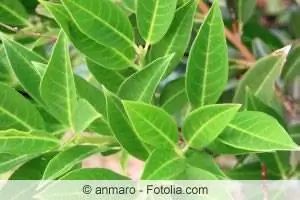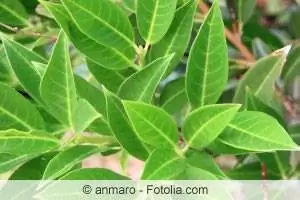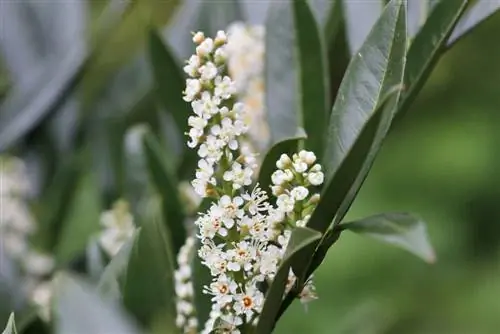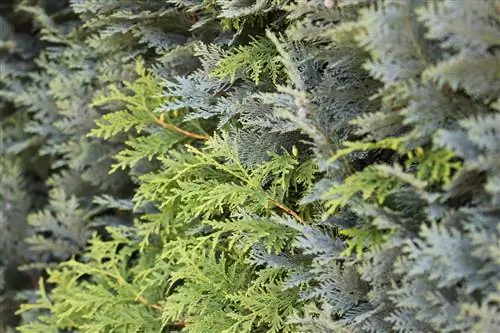- Author admin [email protected].
- Public 2023-12-17 03:39.
- Last modified 2025-01-24 12:45.
The selection of the appropriate hedge planting has been made. Now the delivery or purchase time and, if necessary, correct interim storage are just as important as the best planting time. Legal, regional regulations regarding property boundaries with neighbors must be observed. The distances between the individual plants are also important for an opaque hedge. Good soil preparation and treatment of the freshly planted plants ensure a good start. After all, you want to enjoy your new, he althy hedge as quickly as possible.
Purchase, storage
Hedge plants are available as container plants, ball plants or bare-root plants:
- Container plants: very well rooted. can be used almost at any time; a little more expensive
- Ball plants: compact roots with soil; Loosen the protective fastening before digging in, but do not remove it; available September to May
- Bare-rooted plants: hardly any soil attachments; inexpensive; Before inserting, cut the main roots at an angle for better water absorption; available October to April
Before planting, place the roots in water overnight. Before planting, the balled plant is submerged in water until no more air bubbles appear. If you have to store the purchased goods for a longer period of time, put them together in a large hole in the ground. This must be closed with soil and watered well. In case of frost, the plants can be stored in buckets of soil. Keep moist, but without waterlogging, frost-free and, depending on the variety, store in light (evergreen) or dark (deciduous).
Property boundaries
In Germany, each federal state has its own regulations regarding the distances that must be maintained for border planting. In order to avoid later disputes, it is important to find out more about this in advance. Roughly speaking, it can be said that the distance to the border is one meter or more (depending on the plant). As a rule, the height of the hedge must not exceed 3 meters.
In some federal states, the distance depends on the plant species. In other regions, the height of the plants is important. Disputes with neighbors almost always involve unwanted shading, leaves falling on the property or overhanging branches. You can also be on the safe side if you make an agreement with your neighbor to plant plants on the shared border. This means you can share the costs and work.
Planting time
Late autumn is the best time to plant. Even before the frost comes, the plants can root and sprout in a timely manner in the spring. Of course, planting in spring is also possible. In this case, watering must be carried out carefully and frequently, especially if the summer is very dry. If you have decided on container plants, you can plant at any frost-free season.
Soil preparation, planting spacing
For larger plants, it is not necessary to dig a continuous trench. It is sufficient to dig a suitable deep hole at the respective planting distance. To help ensure that the distances between each other and the border are maintained, you can mark the appropriate planting distances on a bamboo stick. This is then placed along a guide line that has been stretched at the correct distance from the border. The holes are then dug. In any case, it is advisable to loosen the sole thoroughly, especially when it comes to deep-rooted hedge plants.
The excavated material is then mixed with mature compost, as a starting aid. Depending on the nature of the soil and the requirements of the different types, sand can also be mixed in. The depth and width of the excavation depend on the size of the bale and should be a good third larger than this.
The plant spacing between each other is differentiated for a hedge:
- loosely growing natural hedges (ornamental shrubs, deciduous trees): 1 to 2 plants per meter
- strict hedges (conifers, conifers): 2 to 3 plants per meter
- strict hedges (boxwood, privet, barberry): 3 to 5 plants per meter
Another clue is the height of the plants to be used, the smaller, the denser. With a plant size of 40 cm, four plants per meter are calculated, with a plant size of 1.50 m, one to two plants per meter.
Planting, first care
The plants are ultimately sunk to the same depth as they were previously planted in the nursery or container. This can be recognized by the dark discoloration of the root neck. A color difference can also be seen in the bare-root plants. But as with almost all plantings, when in doubt, it is better to plant too shallowly than too deeply.
The loose excavation enriched with nutrients is now filled in around the plant. Carefully move them up and down so that the soil is evenly distributed between the roots. Finally, start lightly and slurry with plenty of water. Also move the plant slightly by shaking it so that no air holes are left on the roots. If necessary, form a watering rim beforehand so that the water cannot find other paths. Once the water has seeped in, the earth's surface is loosened again. Now you can mulch with bark mulch or chaff. This means the soil doesn't dry out so quickly, the roots stay nice and warm and at the same time the weeds are suppressed.

If the roots of the bare-root product have been trimmed, the upper part of the plant must also be shortened accordingly. The first cut on the plants takes place next spring when they are planted in autumn. This is important, even if you think it would be better to let the hedge grow taller first. But it is precisely the early, first cut that allows the plants to sprout twice as vigorously.
Tip:
Often it wasn't the frost that made one or two plants look limp or even dead in spring. Most of the time, the young plants were not provided with enough water over the winter. In frost-free and especially dry periods in winter, don't forget to water!
Planting distance for cherry laurel and thuja
Cherry laurel plants can be purchased in different sizes. To save money, you can choose smaller plants, they grow very quickly. In addition, smaller plants generally root better and start growing more quickly. It is important to pay attention to the final height. There are certainly cherry laurel trees that can grow to be over four meters high. However, most varieties only reach heights of two to three meters. Smaller species only grow up to 50 centimeters, a maximum of one meter. So pay attention to the final height when buying!
Normally, for medium-sized specimens, you can expect two to three plants per linear meter. Of course, you also have to leave enough space if you place it in front of a wall, fence or wall, for example. Somehow you still have to get behind the plant to prune. This must be considered from the start.
The choice of varieties is also large when it comes to Thujen. There are many varieties on offer, from the small spherical shape to the 15 meter high tree. Many are suitable as hedge plants. They are generally frost hardy, easy to care for and undemanding. However, they need water regularly and plenty of it. It should be borne in mind that thujas also need to be pruned regularly, especially if they are used as hedge plants.
Even with Thujen, two to three plants per meter are usually enough. Here, too, you can buy smaller plants as they root better and start growing more quickly. In this way, they usually make up the centimeters that the larger ones lack in two to three years. In about four to five years, a thuja hedge will be around 1.5 to 2 meters high and offers good privacy protection.
Conclusion
Almost all hedge plants are generally quite easy to care for and undemanding. But only those who put in a little effort at the beginning can enjoy this experience. It is worth giving the plants the best starting conditions along the way. This includes a suitable location, well-prepared soil and the correct planting distance. It is also important to maintain the legally required distances from the border. The only thing that requires a little more work in the following years is the regular topiary, if desired, the thinning work as well as the rejuvenation and pruning.






